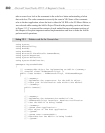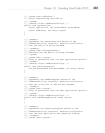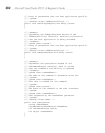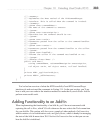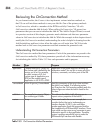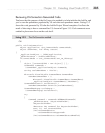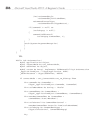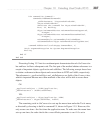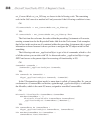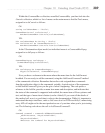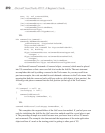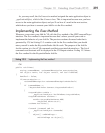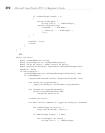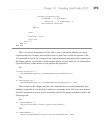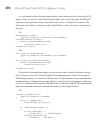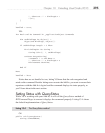
388 Microsoft Visual Studio 2010: A Beginner’s Guide
ext_ConnectMode.ext_cm_UISetup, as shown in the following code. The remaining
code in the OnConnection method will only execute if the following condition is true:
C#:
if(connectMode == ext_ConnectMode.ext_cm_UISetup)
VB:
If connectMode = ext_ConnectMode.ext_cm_UISetup Then
The first time the code runs, the code within the preceding if statement will execute,
creating a menu item for the KeystrokeFinder Add-In in the Tools menu. Code examples
that follow in this section are all contained within the preceding if statement; this is good
information to know because it shows you how to navigate the VS object model to find
something.
The following code uses _applicationObject to get a list of commands, which is a list
of all the actions you can take with VS. As discussed earlier, _applicationObject is type
DTE2 and serves as the parent object for accessing all functionality in VS.
C#:
Commands2 commands =
(Commands2)_applicationObject.Commands;
VB:
Dim commands As Commands2 =
CType(_applicationObject.Commands, Commands2)
In the VS automation object model, a menu item is called a CommandBar. So, you get
a reference to a CommandBars collection, again through _applicationObject, to reference
the MenuBar, which is the main VS menu, assigned to menuBarCommandBar:
C#:
Microsoft.VisualStudio.CommandBars.CommandBar
menuBarCommandBar = ((
Microsoft.VisualStudio.CommandBars.CommandBars)
_applicationObject.CommandBars)["MenuBar"];
VB:
Dim commandBars As CommandBars =
CType(_applicationObject.CommandBars, CommandBars)
Dim menuBarCommandBar As CommandBar =
commandBars.Item("MenuBar")



